153 - Less Common Malignant Tumors of the Esophagus
Editors: Shields, Thomas W.; LoCicero, Joseph; Ponn, Ronald B.; Rusch, Valerie W.
Title: General Thoracic Surgery, 6th Edition
Copyright 2005 Lippincott Williams & Wilkins
> Table of Contents > Volume II > The Mediastinum > Section XXIX - Primary Mediastinal Tumors and Syndromes Associated with Mediastinal Lesions > Chapter 179 - Extended Transsternal Thymectomy
Chapter 179
Extended Transsternal Thymectomy
Akira Masaoka
HISTORICAL ASPECTS OF THYMECTOMY IN PATIENTS WITH MYASTHENIA GRAVIS
Sauerbruch performed a thymectomy in a patient with myasthenia gravis (MG), and this case was published by Schumacher and Roth in 1912. This was the first recorded case of a thymectomy for this disease. The patient was reported to have shown marked improvement of myasthenic symptoms after surgery. This operation was performed via a cervical approach. Subsequently, Veau (1924) reported thymectomies for thymic asthma, because hypertrophic thymus in children was thought to be responsible for this condition. These thymectomies likewise were performed transcervically. In this era, surgeons made a vertical incision in the neck, seized the thymus at its upper poles, and removed the gland by upward traction of the tissue into the neck. The removed thymuses were always partial, since the lower poles of the gland situated beyond the limits of manipulation remained within the confines of the anterior mediastinum.
The pioneer of modern thymic surgery was Alfred Blalock, an American surgeon. Blalock and colleagues (1939) operated on a myasthenic patient with a residual cystic thymic tumor via a median sternotomy from the sternal notch to the third intercostal level. The associated myasthenic symptoms were markedly improved after the removal of the residual thymic tumor. Thereafter, Blalock and co-workers (1941) applied the same procedure of thymectomy for MG in patients without an accompanying thymic tumor. Until 1944, Blalock had performed this procedure in 20 MG patients. The sternal splitting approach allowed direct exposure of the gland, and thus permitted completeness of resection and increased the safety of manipulation of the gland. He commented about the operative approach of thymectomy in his 1939 report:
If it is decided in the future that surgical exploration of the thymic region is indicated in patients with this disease, it should be performed through an approach which gives adequate exposure, such as division of the upper part of the sternum. One should not rely upon the imperfect view which is obtained through an incision in the lower part of the neck.
He performed thymectomies by the sternal splitting method in patients with or without thymoma. The superiority of the transsternal approach over the transcervical approach in accomplishment of thymectomy promoted the choice of the former in many other institutes. An English surgeon, Keynes, followed Blalock's lead in operating through the transsternal approach. Keynes (1946) had split the sternum to the fifth intercostal level at first, but thereafter changed to splitting it only to the fourth intercostal level and adopted the latter as his standard procedure. Keynes (1949) reported that he had performed this procedure in 155 MG patients, and added a method of meticulous vascular dissection based on an exact anatomic knowledge. At Johns Hopkins Hospital, Massachusetts General Hospital, and the Mayo Clinic, thymectomies were performed via this approach, but details of the procedure were not described because most authors at that time who reported the management of MG by thymectomy were not surgeons.
In 1969, Kirschner and colleagues proposed the revival of the transcervical thymectomy approach, which had been abandoned at most institutions by that time. They believed that with the new knowledge of thymic anatomy and adoption of general anesthesia that manipulation and complete resection of the gland could be performed safely via the transcervical approach. They pointed out that the advantages of this procedure were a brief and bland postoperative course, simplified management of MG, good cosmetic effect, and avoidance of pain that occurs after a sternotomy. At the Mt. Sinai Hospital, Papatestas and co-workers (1975, 1987) successfully performed this operation in a large number of patients, and this led to worldwide adoption of the transcervical technique of thymectomy for patients with MG unaccompanied by the presence of a thymoma.
EXTENDED THYMECTOMY
At the Osaka University, transsternal thymectomy through an upper sternal splitting approach had been performed from 1962 to 1970. Thereafter, stimulated by the propaganda of
P.2646
the Mt. Sinai group, transcervical thymectomies were performed in 19 patients with MG during 1971 to March 1973. However, I and my associates found that these patients obtained less benefit postoperatively than those patients treated by transsternal thymectomies that we had performed before 1970. So, we thought that these results might be caused by incompleteness of removal of the thymus. We had noticed that the boundaries of the upper part of the thymus were clear, but those of the lower part were obscure, buried in anterior mediastinal fatty tissue. Therefore, we began an investigation to establish the definitive boundaries of the thymus. Thus, en bloc resections of the thymus including the surrounding fatty tissue in the anterior mediastinum were performed via the sternal splitting approach extending to the fifth intercostal level in 18 patients. The resected specimens were separated into samples of intracapsular thymus gland and extracapsular adipose tissue, and the latter were examined microscopically, to determine whether histologic thymic tissue was present or not. Surprisingly, I and my colleagues (1975) found that in 13 of a total of 18 cases (72.2%), microscopic thymic tissue was present in the gross adipose tissue. These findings led to the assertion that not only the thymic gland, but also the adipose tissue of the anterior mediastinum, contains microscopic thymic tissue, and therefore the adipose tissue should be resected together with the thymus in order to extirpate all of the thymic tissue. Thus, I and Monden (1982) concluded that a procedure to remove the thymus and the surrounding adipose tissue would be more adequate in the treatment of MG, and the procedure was named an extended thymectomy.
Rationale
As just described, thymic tissue is scattered in the surrounding adipose tissue around the thymus. However, the origin of this tissue is obscure. The descent of the thymic gland from the neck to the thorax in its embryonal developmental course might be responsible for such ectopic thymic tissue, and the highly frequent presence of thymic tissue in the gross adipose tissue in the anterior mediastinum is the rationale for the extended thymectomy. It is important to stress that to remove the thymus and the surrounding adipose tissue totally, the extended thymectomy should be performed transsternally, not by a cervical approach. The transsternal approach permits good exposure, safe manipulation, and allows complete resection of the entire thymus and the parathymic fat. The extended transsternal thymectomy is now one of most prevailing procedures in the thymectomy family. Aggressive transsternal thymectomy as suggested by Fischer and co-workers (1987) and the radical transsternal thymectomy advocated by Hatton (1989) and Roth (2002) and their associates are examples of an extended thymectomy.
In order to decide whether this procedure could be meaningful in MG treatment, the superiority of the results of its use over that of other procedures must be proved. At Osaka University, three different procedures for MG had been performed until 1980: (a) transsternal simple thymectomy (removal of only intracapsular thymus through a transsternal approach) from 1962 to 1970; (b) transcervical simple thymectomy (removal of intracapsular thymus through a transcervical approach) from 1971 to March 1973, and (c) extended thymectomy from April 1973 to 1980. In 1982, the results of these three procedures in the nonthymomatous MG patients were investigated and compared. The effects of thymectomy were evaluated at 3 months, 6 months, 1 year, 3 years, 5 years, and 10 years postoperatively, according to specific criteria [i.e., (a) remission, no symptom without medication; (b) improvement, increased activity with less medication; (c) no clinical change; (d) more medication and/or worse symptoms; and (e) death caused by MG]. Remission rate (RR) and palliation rate (PR) were calculated according to the following formulas: RR = number of A/total number, PR = number of A and B/total number. Total number is defined as the total number of patients for whom information about clinical status at each follow-up visit was obtained. A is the number of patients defined by criterion (a) and B is the number of patients defined by criterion (b), as defined previously.
Remission rate curves and PR curves of transsternal simple thymectomy (23 cases), transcervical simple thymectomy (19 cases), and extended transsternal thymectomy (95 cases) in the nonthymomatous patients with MG are shown in Figs. 179-1 and 179-2. The RRs of transsternal simple thymectomy and extended thymectomy at 3- and 5-year follow-up exceeded those of transcervical simple thymectomy. On the other hand, the PRs of extended
P.2647
thymectomy at 3-month, 6-month, 1-year, and 3-year follow-up exceeded those of transsternal simple thymectomy and transcervical simple thymectomy. Many believe that comparison of PR is not reliable because of the differences of standards of evaluation in each institute; however, in the aforementioned data, it is reasonably justified because all of the thymectomies were performed in a single institute, and the results were judged by the same, single physician.
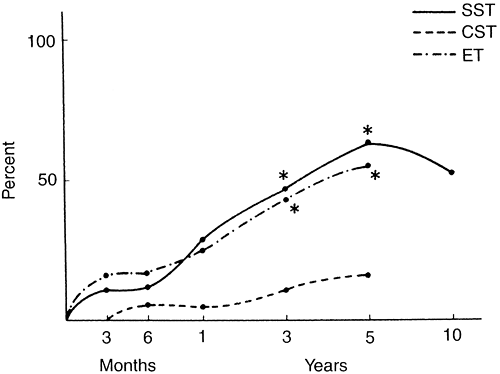 |
Fig. 179-1. Remission curves of transcervical simple thymectomy (CST), intracapsular thymus (SST), and extended thymectomy (ET). *Significantly different from CST. From Masaoka A, Monden Y: Comparison of the results of transsternal simple, transcervical simple, and extended thymectomy. Ann NY Acad Sci 377:755, 1981. With permission. |
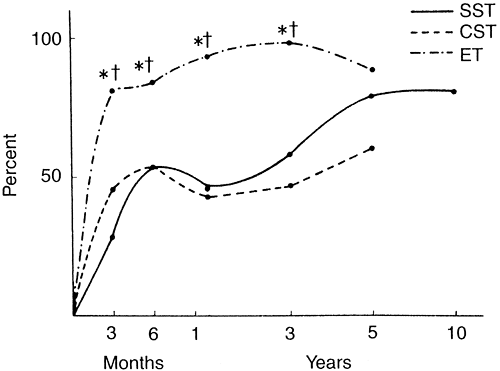 |
Fig. 179-2. Palliation curves of transcervical simple thymectomy (CST), intracapsular thymus (SST), and extended thymectomy (ET). *Significantly different from CST significantly different from SST. From Masaoka A, Monden Y: Comparison of the results of transsternal simple, transcervical simple, and extended thymectomy. Ann NY Acad Sci 377: 755, 1981. With permission. |
Thus, I and Monden (1982) concluded that the results of extended thymectomy are superior to those of transsternal simple thymectomy and transcervical simple thymectomy. This conclusion includes three separate statements: (a) extended thymectomy is superior to transcervical simple thymectomy, (b) extended thymectomy is superior to transsternal simple thymectomy, and (c) transsternal simple thymectomy is superior to transcervical simple thymectomy.
Matell and colleagues (1982) reported that in their institute the procedure of thymectomy changed from simple transsternal (46 cases) to simple transcervical thymectomy (95 cases). The follow-up results in both groups revealed that 77% of the patients in the transsternal group showed improvement, but only 39% in the transcervical group did so.
Disappointed with the results of the transcervical simple thymectomies, Maggi and co-workers (1989) changed to a combined method of transcervical and transsternal approache and reported the results in 622 cases. The transcervical/transsternal approach consisted of a transverse cervical incision with upper sternal splitting of 8 to 10 cm in length aimed to permit the removal of all of the anterior mediastinal adipose tissue. Venuta and co-workers (1999) from Rome (232 cases) and Levasseur (1989) from Paris (720 cases) adopted a similar procedure instead of the transcervical simple thymectomy. Mulder and associates (1989) from Los Angeles (333 cases) changed their procedure of choice from the transsternal simple thymectomy to the extended thymectomy. Likewise, Evoli and co-workers (1988) from Rome (247 cases) adopted the extended thymectomy with an upper sternal split method instead of a transcervical thymectomy. However, these researchers did not compare the results of the former and the latter procedures. Recently, Chen and colleagues (2002) adopted an anterosuperior cervicomediastinal resection technique, but no hard data were presented.
Additional evidence suggesting superiority of the extended thymectomy is the effects of this procedure in patients who were not benefited by a transcervical or transsternal simple thymectomy. In 1982, I and colleagues reported on six patients who underwent reoperation by the extended thymectomy after previous transcervical thymectomies. We (1982) found residual thymic tissue that was situated below the left brachiocephalic vein (average weight 19 g) in all six patients. This suggests technical shortcomings involved in the transcervical thymectomy (i.e., limited exposure, difficulty of manipulation, and incompleteness of removal). Postoperatively, four of the six patients obtained good results. Henze and colleagues (1984) reported the largest series of failed transcervical thymectomies. Twenty of 95 patients (27%) who had undergone a thymectomy by the transcervical approach underwent reoperation by an extended transsternal procedure. In 18 patients thymic tissue was found, and overall 19 patients improved. Rosenberg and associates (1986) reoperated on 13 transcervically thymectomized patients, and found residual thymic tissue in 11. Six of the nine patients who underwent later follow-up were improved. These findings further justify the use of the extended thymectomy. Thus, many surgeons have adopted the extended thymectomy, the rationale of the procedure being accepted by many general thoracic surgeons and neurologists.
Various other procedures were developed following the introduction of the extended thymectomy. One of these new procedures was developed by Jaretzki and Wolff (1988) and was aimed at enlarging the extent of removed adipose tissue both in the thorax and in the cervical area adjacent to the thyroid gland. These researchers found thymic tissue to be present in the adipose tissue in the neck and in the deep mediastinum beyond the extent of excision of the adipose tissue by the extended thymectomy, and advocated a maximal thymectomy to remove all of the adipose tissue in those regions. Other procedures were developed to perform the extended thymectomy under a minimally invasive method, that is: (a) transcervical approach with specific sternal retractor, (b) transcervical approach with upper sternal split, and (c) video-assisted thoracoscopic surgery (VATS) thymectomy. Merits and demerits of these procedures as well as the extended transsternal thymectomy should be investigated and discussed, as proposed by Jaretzki and co-workers (2000).
P.2648
Technique of the Extended Transsternal Thymectomy
The extended transsternal thymectomy is defined as a procedure to remove the thymus and its surrounding adipose tissue in the anterior mediastinum by sternal splitting. However, the operation has many variations or modifications in its technical detail. I will describe my usual procedure in detail and add some modifications performed by other surgeons.
The patient, in a supine position under induction with thiopental sodium, is intubated with an endotracheal single-lumen tube. Muscle relaxants are avoided because some patients with MG are hypersensitive to these drugs. After intubation, a small pillow is inserted behind the shoulders to extend the neck somewhat posteriorly. A longitudinal skin incision is made from the level of the upper edge of the manubrium sterni to the level of the lower end of the corpus sterni (Fig. 179-3). It is possible that the length of the skin incision can be shortened somewhat by a wide subcutaneous dissection. Mulder (1996) recommended a submammary wavy transverse skin incision in most women for cosmetic reasons. Budde and colleagues (2001) recommended a T-shaped skin incision to eliminate the upper part of longitudinal incision. After the chosen skin incision, the sternum is split with a sternal saw. I prefer to split the sternum from the manubrium to the fifth intercostal level; the remaining 1-cm long portion of the sternal body is left intact (Fig. 179-4). This split can allow a successful extended thymectomy and serves to keep the postoperative form of the sternum. Some surgeons, such as Mulder (1996) and Mussi and associates (2001), use a complete sternal split, but I do not use it except in cases with a thymoma located at the lower pole. I think the sternal split to the fifth intercostal level is enough in nonthymomatous patients with MG. On the other hand, some surgeons decrease the length of the sternal split. Cohn (1974) and Pego-Fernandes (2002) and their co-workers adopt a short sternal split to the fourth intercostal level. Grandjean and associates (2000) recommend a reversed-T upper mini-sternotomy to be a less invasive method.
 |
Fig. 179-3. Skin incision. |
 |
Fig. 179-4. Sternum split. |
A small retractor is inserted, and the sternum is opened slowly to prevent disruption of the left brachiocephalic vein (Fig. 179-5). The intent of the extended thymectomy is the removal of all thymic tissue and the surrounding adipose tissue in the anterior mediastinum. The extent of the dissection is set as follows: (a) the lower poles of the thyroid gland (upper limit), (b) the diaphragm (lower limit), and (c) the surrounding regions of the phrenic nerves bilaterally (posterior limit), as shown in Fig. 179-6.
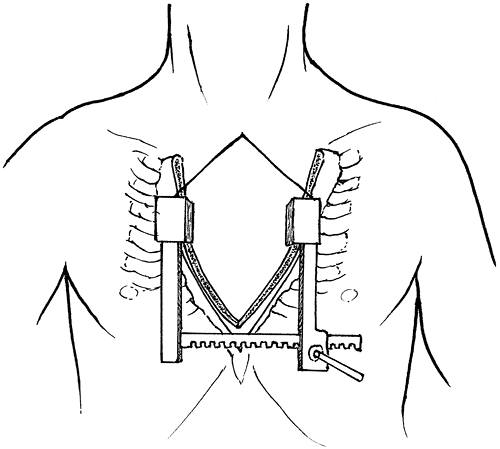 |
Fig. 179-5. Exposure of mediastinum. |
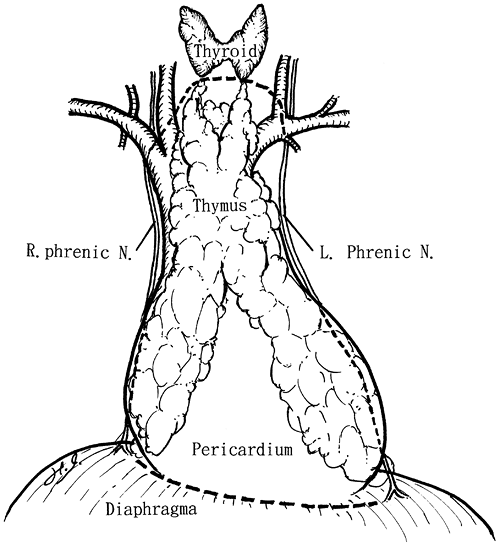 |
Fig. 179-6. Extent of resection. |
P.2649
Usually the dissection is started at the lower poles of the anterior mediastinal adipose tissues, which are located immediately on the upper surface of the diaphragm (Fig. 179-7). Blunt separation of the adipose tissue from the diaphragm and pericardium can be easily performed. However, as the adipose tissues of the left side extend posteriorly to the back side of heart, meticulous manipulation is necessary in dissection of this area.
Next, separation of the adipose tissue from the pleura is performed bilaterally, and the boundary of phrenic nerves is identified as the boundary of the posterior limits (Fig. 179-8). Gentle manipulation is necessary to avoid phrenic nerve injuries. Separation around phrenic nerves is easy at the caudal region, but more difficult at the cephalad region from level of the hilum of the lung upwards (Fig. 179-9). Sometimes mediastinal adipose tissues connect with intrapleural adipose tissues beyond the pleura. In such a case, both areas of adipose tissue should be resected with the adjacent pleura (Fig. 179-10).
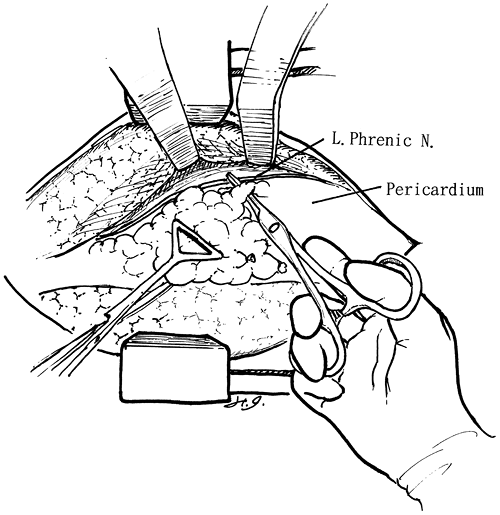 |
Fig. 179-8. Dissection of adipose tissue near phrenic nerve. |
 |
Fig. 179-7. Dissection of adipose tissue from diaphragm. |
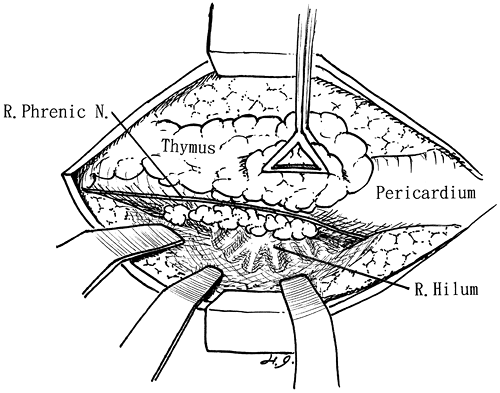 |
Fig. 179-9. Dissection of adipose tissue at hilar level. |
P.2650
When the mediastinal adipose tissues of both sides are dissected upward, these join the original thymus. Usually the adipose tissues at the pulmonary hila are not resected. The adipose tissues lateral to the thymus at the upper part of mediastinum are dissected carefully without traction of those tissues because the phrenic nerves are less obvious and easily injured. The adipose tissues in the middle or posterior mediastinum, such as the aorticopulmonary window area, are not resected. When the thymic arteries arising from the internal thoracic arteries are found, they should be dissected free, ligated, and divided (Fig. 179-11). Thus, the thymus and the mediastinal adipose tissues are turned upward en bloc, and the thymic vein, or infrequently more than one vein, from the left brachiocephalic vein is ligated and divided (Fig. 179-12).
As the upper poles of the thymus are encapsulated clearly, separation from surrounding tissues is easy. The upper poles are traced to the thyroid and dissected from it (Fig. 179-13). Usually systematic dissection of the adipose tissue in the neck is not performed. Sometimes one of the upper poles of the thymus is located posteriorly to the left brachiocephalic vein. Careful inspection can find this anomaly. The transsternal
P.2651
approach allows ready access to resect this aberrantly located thymic tissue.
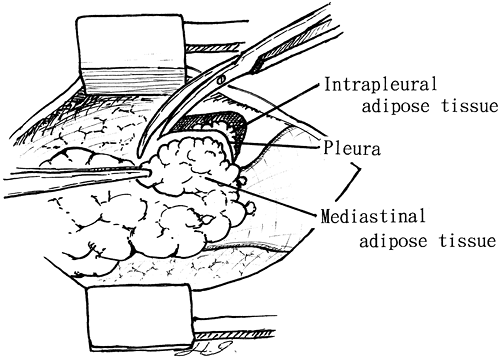 |
Fig. 179-10. Dissection of mediastinal and intrapleural adipose tissue. |
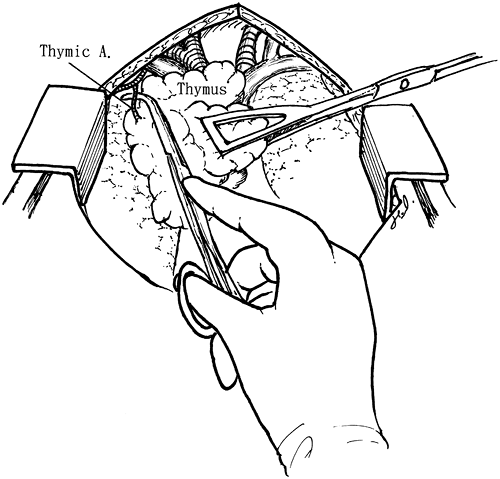 |
Fig. 179-11. Dissection of adipose tissue at cranial region of mediastinum, and ligation of thymic artery. |
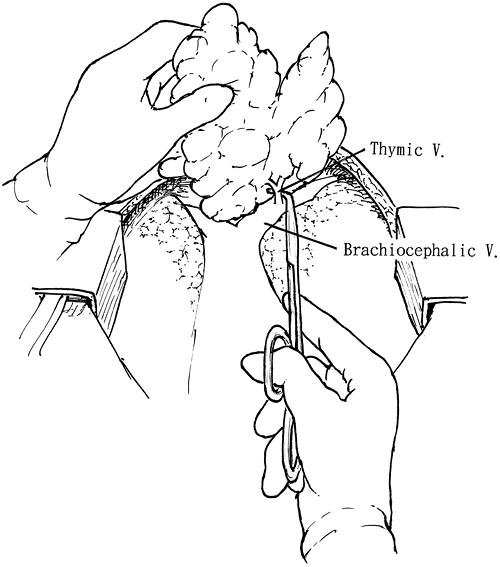 |
Fig. 179-12. Ligation of thymic vein. |
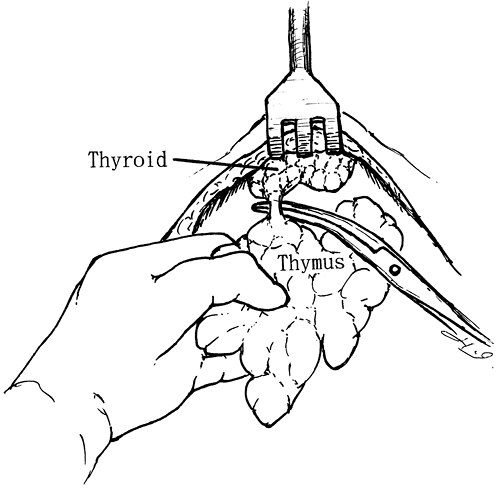 |
Fig. 179-13. Dissection of upper pole. |
In thymomatous MG, the operative procedure is similar to that of nonthymomatous MG, especially in the case of a small and noninvasive thymoma. However, in the case of a large or invasive thymoma, modification of the approach is necessary. The preferred method is an L-shaped approach that consists of a longitudinal sternal split and an anterior intercostal thoracotomy on the side of the tumor, usually at either the fourth or fifth intercostal space (Fig. 179-14). In such a case, the sternum is split first and the lower pole with the lateral adipose tissues on the contralateral side of the tumor are dissected. The reason to proceed initially with the dissection of mediastinal adipose tissues on the contralateral side of the tumor is the difficulty of this manipulation under the condition of an established L-shaped thoracotomy. Subsequently, the intercostal thoracotomy is performed. This provides an excellent exposure of the tumor and permits manipulation, including resection of any invaded organs. A chest tube is positioned in the anterior mediastinum. If a pleural cavity is opened widely, an ipsilateral thoracic tube also is inserted.
Results
The extended thymectomy as described has been performed for MG since 1973 at the Osaka University Hospital, and since 1985 at the Nagoya City University Hospital. In 1996, 384 patients with MG who underwent extended thymectomies from 1973 to 1993 in both institutes were reviewed by myself and associates. These cases consisted of 286 nonthymomatous and 98 thymomatous patients. The former underwent the extended thymectomy and the latter underwent the extended thymectomy with total resection of the thymoma.
The results of nonthymomatous and thymomatous patients were evaluated separately to study the effects of the extended thymectomy by RRs and PRs at 3 months, 6 months, 1 year, 3 years, 5 years, 10 years, 15 years, and 20 years postoperatively. The results are shown in Figs. 179-15 and 179-16. The RR curves and the PR curves of both groups elevated gradually with the passage of time. In the nonthymomatous group, the RRs were 36.9% (3 years), 45.8% (5 years), 55.7% (10 years), and reached a peak of 67.2% at 15 years. On the other hand, the PR curve reached 74% at 3 months, then increased gradually until year 3 and plateaued at over 90% thereafter. In the thymomatous group, the RR curve rose gradually, reaching 32.4% at 3 years and plateaued. The PR curve reached 82.5% at 1 year and plateaued. The RRs of the nonthymomatous group exceeded those of the thymomatous group after 5 years (p < 0.01 at 5, 10, and 15 years). The PRs of the nonthymomatous group exceeded those of the thymomatous group at some points of evaluation (p < 0.01 at 3 and 15 years; p < 0.05 at 3 months and 10 years).
Usually, RR and PR are used as parameters to evaluate the effects of thymectomy for MG. RR and PR tend to elevate,
P.2652
corresponding with the time course. Accordingly, these should be calculated at defined periods of time after thymectomy. I used to apply RR and PR at defined times as parameters to be comparable with other reports. Jaretzki (1997) named these the Oosterhuis-Masaoka formula. However, many researchers use crude RR (number of remission/number of thymectomies 100%, unspecified time after thymectomy), and crude PR (number of palliation/number of thymectomies 100%, unspecified time after thymectomy). It is difficult to compare crude RRs or crude PRs in meta-analysis of many reports, because their follow-up periods are varied.
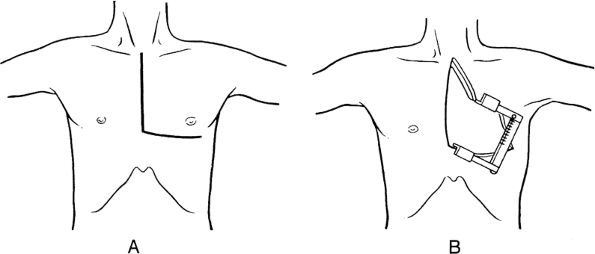 |
Fig. 179-14. L-shaped approach. |
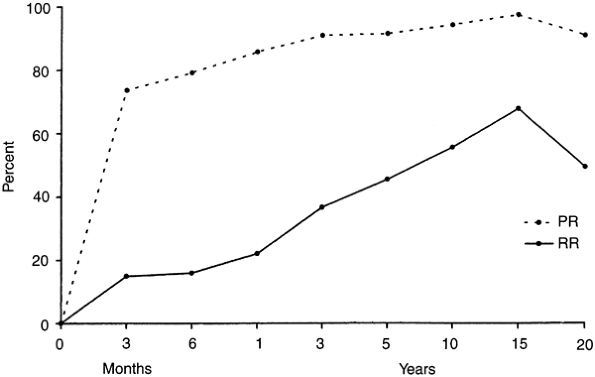 |
Fig. 179-15. Remission and palliation curve in thymectomized nonthymomatous patients with myasthenia gravis. From Masaoka A, et al: Extended thymectomy for myasthenia gravis patients: a 20-year review. Ann Thorac Surg 62:853, 1996. With permission. |
Table 179-1 shows the results of extended transsternal thymectomy in the institutes, which performed over 40 thymectomies. This table summarizes the results of reports after 1987. RR is adopted as the most representative parameter (if available, time-defined RR, otherwise crude RR). If RRs are not available, PRs are substituted for RR. Although most reports apply remission without medication as the numerator in the RR formula, Mussi and colleagues (2001) apply remission with and without medication as the numerator. In addition, they use RR by life-table analysis. However, I doubt whether life-table analysis with the Kaplan-Meier method could be applied in follow-up of MG, because the once remitted MG patients might relapse thereafter. Many reports use crude RR as the representative parameter, especially in small series. Also, separation of nonthymomatous and thymomatous MG is incomplete in many reports. In Table 179-1, the results of nonthymomatous MG are described, if both groups were investigated separately. Furthermore, there are delicate differences between the various evaluations. The methods of Budde (2001) and Pego-Fernandes (2002) and their colleagues are somewhat different from the others as described previously.
The results in Table 179-1 should be evaluated with the consideration of various aspects in each report. The later the postoperative statuses are evaluated, the higher the RRs reach. The longer the average observation periods are, the higher the crude RRs are. The results in the thymomatous
P.2653
MG groups are lower than those of the nonthymomatous MG groups. Accordingly, it is difficult to compare the results with each other. Likewise, comparison of the results between different operative procedures is difficult. An accurate system of evaluation of the results should be established, as has been suggested by Jaretzki and coinvestigators (2000).
 |
Fig. 179-16. Remission and palliation curve in thymectomized thymomatous patients with myasthenia gravis. From Masaoka A, et al: Extended thymectomy for myasthenia gravis patients: a 20-year review. Ann Thorac Surg 62:853, 1996. With permission. |
Table 179-1. Results of Extended Transsternal Thymectomy | ||||||||||||||||||||||||||||||||||||||||||||||||||||||||||||||||||||||||||||||||||||||||||||||||||||||||||||||||||||||||||||||||||||||||||||||
|---|---|---|---|---|---|---|---|---|---|---|---|---|---|---|---|---|---|---|---|---|---|---|---|---|---|---|---|---|---|---|---|---|---|---|---|---|---|---|---|---|---|---|---|---|---|---|---|---|---|---|---|---|---|---|---|---|---|---|---|---|---|---|---|---|---|---|---|---|---|---|---|---|---|---|---|---|---|---|---|---|---|---|---|---|---|---|---|---|---|---|---|---|---|---|---|---|---|---|---|---|---|---|---|---|---|---|---|---|---|---|---|---|---|---|---|---|---|---|---|---|---|---|---|---|---|---|---|---|---|---|---|---|---|---|---|---|---|---|---|---|---|---|
| ||||||||||||||||||||||||||||||||||||||||||||||||||||||||||||||||||||||||||||||||||||||||||||||||||||||||||||||||||||||||||||||||||||||||||||||
REFERENCES
Blalock A: Thymectomy in the treatment of myasthenia gravis. J Thorac Surg 13:316, 1944.
Blalock A, et al: Myasthenia gravis and tumors of the thymic region. Ann Surg 110:544, 1939.
Blalock A, et al: The treatment of myasthenia gravis by removal of the thymus gland. Preliminary report. JAMA 117:1529, 1941.
Budde JM, et al: Predictors of outcome in thymectomy for myasthenia gravis. Ann Thorac Surg 72:197, 2001.
Chen H, et al: Technique of thymectomy by anterior-superior cervicomediastinal exenteration. J Am Coll Surg 195:895, 2002.
Cohn HE, et al: Surgical treatment in myasthenia gravis A 27 year experience. J Thorac Cardiovasc Surg 68:876, 1974.
Evoli A, et al: Thymectomy in the treatment of myasthenia gravis: report of 247 patients. J Neurol 235:272, 1988.
Fischer JE, et al: Aggressive surgical approach for drug-free remission from myasthenia gravis. Ann Surg 205:496,1987.
Frist WH, et al: Thymectomy for the myasthenia gravis patient: factors influencing outcome. Ann Thorac Surg 57:334, 1994.
Grandjean JG, Lucchi M, Mariani MA: Reversed-T upper mini-sternotomy for extended thymectomy in myasthenic patients. Ann Thorac Surg 70:1423, 2000.
Hatton PD, et al: Transsternal radical thymectomy for myasthenia gravis: a 15-year review. Ann Thorac Surg 47:838, 1989.
Henze A, et al: Failing transcervical thymectomy in myasthenia gravis. An evaluation of transsternal re-exploration. Scand J Thorac Cardiovasc Surg 18:235, 1984.
Huang MH, et al: The outcome of thymectomy in nonthymomatous myasthenia gravis. Surg Gynecol Obstet 166:436, 1988.
Jaretzki A III: Thymectomy for myasthenia gravis: analysis of controversies regarding technique and results. Neurology 48(suppl 5):52, 1997.
Jaretzki A III, Wolff M: Maximal thymectomy for myasthenia gravis. Surgical anatomy and operative technique. J Thorac Cardiovasc Surg 96:711, 1988.
Jaretzki A III, et al: Myasthenia gravis: recommendations for clinical research standards. Ann Thorac Surg 70:327, 2000.
Keynes G: The surgery of the thymus gland. Br J Surg 33:201, 1946.
Keynes G: The results of thymectomy in myasthenia gravis. Br Med J 2:611, 1949.
Kirschner PA, Osserman KE, Kark AE: Studies in myasthenia gravis. Transcervical total thymectomy. JAMA 209:906, 1969.
Klein M, et al: Early and late results after thymectomy in myasthenia gravis: a retrospective study [correction of analysis]. Thorac Cardiovasc Surg 47:170, 1999.
Levasseur P: Discussion of Maggi's article: thymectomy in myasthenia gravis. Results of 662 cases operated upon in 15 years. Eur J Cardiothorac Surg 3:504, 1989.
Lindberg C, et al: Remission rate after thymectomy in myasthenia gravis when the bias of immunosuppressive therapy is eliminated. Acta Neurol Scand 86:323, 1992.
Maggi G, et al: Thymectomy in myasthenia gravis. Results of 662 cases operated upon in 15 years. Eur J Cardiothorac Surg 3:504, 1989.
Masaoka A, Monden Y: Comparison of the results of transsternal simple, transcervical simple, and extended thymectomy. Ann NY Acad Sci 377:755, 1981.
Masaoka A, Nagaoka Y, Kotake Y: Distribution of thymic tissue at the anterior mediastinum. Current procedures in thymectomy. J Thorac Cardiovasc Surg 70:747, 1975.
Masaoka A, et al: Reoperation after transcervical thymectomy for myasthenia gravis. Neurology (NY) 32:83, 1982.
Masaoka A, et al: Extended thymectomy for myasthenia gravis patients: a 20-year review. Ann Thorac Surg 62:853, 1996.
Matell G, et al: Follow-up comparison of suprasternal vs transsternal method for thymectomy in myasthenia gravis. Ann NY Acad Sci 377:844, 1982.
Mulder DG: Extended transsternal thymectomy. Chest Surg Clin North Am 6:95, 1996.
Mulder DG, Graves M, Hermann C: Thymectomy for myasthenia gravis: recent observations and comparisons with past experience. Ann Thorac Surg 48:551, 1989.
Mussi A, et al: Extended thymectomy in myasthenia gravis: a team-work of neurologist, thoracic surgeon and anaesthesist may improve the outcome. Eur J Cardiothorac Surg 19:570, 2001.
Nieto IP, et al: Prognostic factors for myasthenia gravis treated by thymectomy: review of 61 cases. Ann Thorac Surg 67:1568, 1999.
P.2654
Olanow CW, et al: Thymectomy as primary therapy in myasthenia gravis. Ann NY Acad Sci 505:595, 1987.
Papatestas AE, et al: Transcervical thymectomy in myasthenia gravis. Surg Gynecol Obstet 140:535, 1975.
Papatestas AE, et al: Effects of thymectomy in myasthenia gravis. Ann Surg 206:79, 1987.
Pego-Fernandes PM, et al: Thymectomy by partial sternotomy for the treatment of myasthenia gravis. Ann Thorac Surg 74:204, 2002.
Rosenberg M, et al: Recurrence of thymic hyperplasia after trans-sternal thymectomy in myasthenia gravis. Chest 89:888, 1986.
Roth T, et al: Thirteen years follow-up after radical transsternal thymectomy for myasthenia gravis. Do short-term results predict long-term outcome? Eur J Cardiothorac Surg 21:664, 2002.
Schumacher ED, Roth J: Thymektomie bei einem Fall von Morbus Basedowi mit Myasthenie. Mitt Grenzgeb Med Chir (Jena) 25:746, 1912.
Scott W, Detterbeck F: Transsternal thymectomy for myasthenia gravis. Semin Thorac Cardiovasc Surg 11:54, 1999.
Stern LE, et al: Long-term evaluation of extended thymectomy with anterior mediastinal dissection for myasthenia gravis. Surgery 130:774, 2001.
Tsuchida M, et al: Efficacy and safety of extended thymectomy for elderly patients with myasthenia gravis. Ann Thorac Surg 67:1563, 1999.
Veau V: Chirurgie du thymus dans la premi re enfence. In Mayer L (ed): Sixi me Congr s de la Soci t Internationale de Chirurgie, Vol. 1, July 17 20, 1923. London: Imprimerie M dicale et Scientifique, Brussels, 1924, p. 267.
Venuta F, et al: Thymectomy for myasthenia gravis: a 27-year experience. Eur J Cardiothorac Surg 15:621, 1999.
EAN: 2147483647
Pages: 203